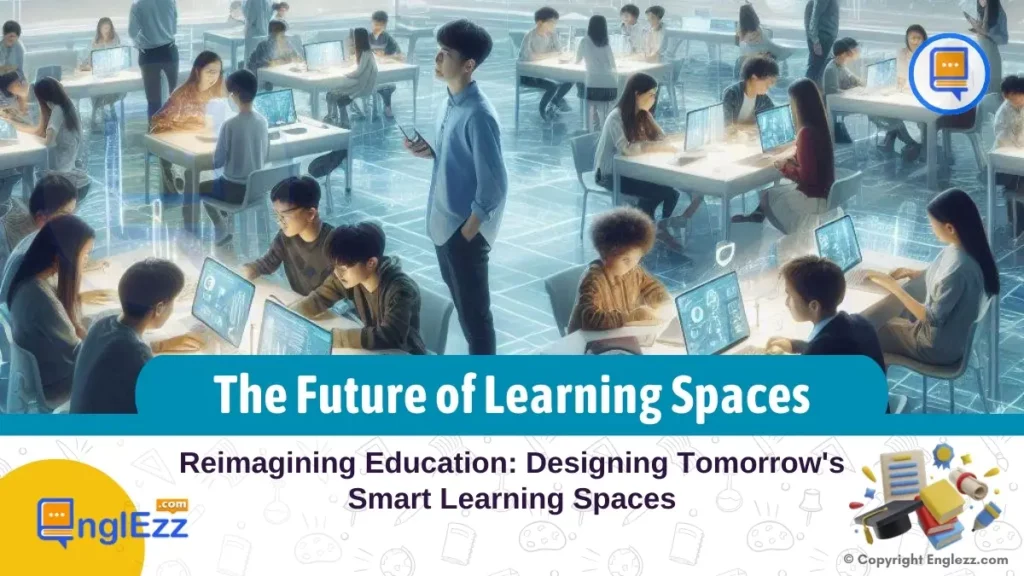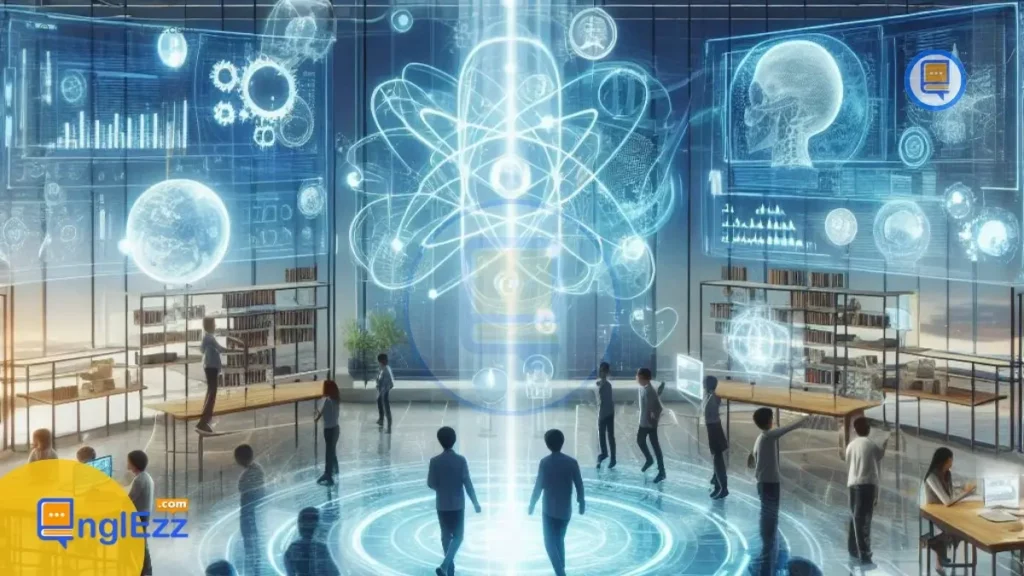In a world where education is continuously evolving, the very spaces in which we learn must adapt to meet the demands of tomorrow. Welcome to the realm of smart learning spaces, where innovation intertwines seamlessly with tradition to redefine the educational landscape. Through a visionary lens, we witness the birth of environments that not only house knowledge but actively cultivate it—a paradigm shift set to revolutionize how we perceive classrooms and empower educators worldwide. Imagine a place where walls are no longer barriers but gateways to boundless possibilities, where technology isn’t just a tool but a conduit for transformative learning experiences.
The Future of Learning Spaces: Designing Intelligent Environments for Education Management
As we embark on this journey of reimagining education through intelligent environments, one thing becomes abundantly clear: the future belongs to those who embrace change and dare to innovate. Gone are the days of static chalkboards and rigid rows of desks; enter an era where design principles harmonize with cutting-edge technologies to foster creativity, collaboration, and curiosity within educational settings. It’s not merely about aesthetic makeovers or flashy gadgets—it’s about crafting dynamic spaces that pulse with energy, adaptability, and purpose.

The very essence of learning is poised for a monumental shift as we harness the power of innovative designs and technology to breathe new life into traditional classrooms, ushering in an era where every corner holds the promise of unlocking untapped potential. Join us as we delve into this exciting frontier, where intelligence meets inspiration in crafting tomorrow’s smart learning spaces – a testament to our unwavering commitment to shaping a brighter future through education.
Understanding the Evolving Educational Landscape
In the realm of education, the landscape is undergoing a dynamic transformation, embracing flexible layouts to meet the diverse needs of learners in this digital era. Traditional classrooms are giving way to adaptable spaces that can flexibly accommodate different teaching and learning styles. For instance, the concept of agile learning environments where furniture and technology can be easily rearranged to support group work, individual study, or interactive sessions is gaining traction. This shift not only fosters collaboration and creativity but also empowers educators to tailor their instructional approaches more effectively.
Smart technologies are playing a pivotal role in revolutionizing teaching methods within educational settings. From interactive displays that engage students in immersive learning experiences to AI-powered tools that offer personalized interventions based on each learner’s pace and preferences, these innovations are reshaping the dynamics of classrooms around the globe. Educators now have access to data-driven insights that facilitate targeted interventions and adaptive instruction, thereby enhancing student engagement and academic outcomes. By leveraging smart technologies intelligently, educators can create enriched learning environments that resonate with today’s tech-savvy generation.
The necessity for adaptive environments in education stems from the recognition that students have diverse learning styles and preferences. Designing spaces that can adjust to cater to visual, auditory, kinesthetic, or social learners enables educators to address individual needs effectively. For example, incorporating sensory-friendly elements like adjustable lighting or tactile surfaces can create inclusive environments where all students feel supported in their academic journey. By emphasizing adaptability in educational spaces through versatile design elements and technological integration tailored to different learning modalities, institutions can foster an inclusive culture that celebrates diversity and promotes equitable access to quality education for all learners.
Designing Smart Learning Spaces
Designing smart learning spaces entails integrating key design principles that center on adaptability, sustainability, and technology immersion. Flexibility in educational environments is crucial to cater to diverse teaching methods and student preferences. For instance, modular furniture arrangements that can be easily reconfigured allow for seamless transitions between individual work, group projects, or lectures. Schools like the Riverside Learning Center have successfully implemented movable partitions and flexible seating options to transform traditional classrooms into dynamic learning hubs that inspire collaboration and innovation.
Sustainability is another cornerstone of smart learning space design, emphasizing eco-friendly materials, energy-efficient systems, and waste reduction strategies. The Green School in Bali exemplifies this by embracing sustainable architecture with bamboo structures and rainwater harvesting techniques. By prioritizing environmentally conscious practices, schools not only reduce their carbon footprint but also instill values of environmental stewardship among students.
Integrating technology seamlessly into learning environments enhances student engagement and interactive experiences. Smart boards, virtual reality sets like Google Expeditions, or coding stations introduce innovative ways to deliver curriculum content effectively. For instance, the Oslo International School integrates augmented reality apps into science classes to simulate experiments in a virtual lab setting. Such technologically advanced spaces bridge the gap between theoretical knowledge and practical application while sparking curiosity and creativity among students.
Furthermore, incorporating elements of nature within smart learning spaces has proven benefits on student well-being and cognitive performance. Biophilic design principles promote connections with nature through green walls, natural light sources, or indoor gardens. Studies show that environments rich in biophilic elements contribute to reduced stress levels, improved focus, and increased productivity among learners. Schools like the Caverly School blend outdoor landscapes with indoor classrooms to create an immersive environment where students feel connected to the natural world while pursuing academic excellence.
Technology Integration in Education Management
In the realm of education management, technology has emerged as a powerful ally in streamlining administrative tasks and enhancing operational efficiency. By leveraging data analytics and Internet of Things (IoT) devices, educational institutions can gain insights into student performance metrics, optimize resource allocation, and make data-driven decisions to improve overall learning outcomes. For instance, a school district implementing IoT sensors in classrooms can monitor real-time occupancy rates to efficiently manage classroom spaces and ensure a conducive learning environment for students.
The integration of virtual reality (VR) and augmented reality (AR) tools presents exciting opportunities for immersive educational experiences. Imagine students exploring ancient ruins through VR simulations or conducting science experiments in virtual laboratories with AR overlays. These technologies not only engage learners on a deeper level but also foster creativity and critical thinking skills. For example, medical schools are utilizing VR to simulate surgical procedures for hands-on training without the need for physical cadavers, revolutionizing healthcare education practices.
Furthermore, by embracing technology in education management, administrators can automate routine tasks like scheduling, grading assessments, and communication with parents or guardians. This automation allows educators to focus more on personalized instruction and mentorship while providing timely feedback to students. Through comprehensive Learning Management Systems (LMS) powered by AI algorithms, teachers can tailor lessons to individual learning styles and track student progress effectively. Overall, technology serves as a catalyst for innovation in education management, paving the way for more efficient processes and improved student engagement.
Enhancing Teaching Methods through Innovative Spaces
In the realm of education, the integration of smart learning spaces holds the key to unlocking personalized learning experiences for students. By leveraging interactive displays, educators can create immersive environments that cater to individual learning styles and preferences. For instance, imagine a science classroom where students can interact with 3D models of molecules or conduct virtual experiments using augmented reality tools. These innovative approaches not only enhance student engagement but also foster a deeper understanding of complex concepts by making learning more tangible and memorable.
Gamification is another powerful tool that can transform traditional classrooms into dynamic learning environments. By introducing elements of competition, collaboration, and rewards into lessons, teachers can motivate students to actively participate in their own education. For example, educational platforms like Kahoot! utilize game-based quizzes to reinforce key concepts in a fun and interactive way. This gamified approach not only excites students about learning but also helps educators assess comprehension levels and adapt teaching strategies accordingly.
Furthermore, AI-powered tools play a crucial role in shaping the future of education by providing personalized support to learners. Adaptive learning systems analyze student performance data in real-time to deliver tailored content and interventions based on individual strengths and weaknesses. By creating bespoke lesson plans and assessments, these technologies enable students to progress at their own pace and receive targeted assistance when needed. With digital whiteboards and collaborative software becoming commonplace in modern classrooms, teachers can effortlessly share resources, facilitate group projects, and encourage peer-to-peer learning—all contributing to a more interactive and inclusive educational experience for students worldwide.
Sustainability and Wellness in Educational Environments
In the pursuit of creating future-ready learning environments, sustainability has become a cornerstone for educational facilities worldwide. By incorporating sustainable practices in building design and operations, schools not only reduce their environmental footprint but also foster a culture of environmental stewardship among students. For example, schools can integrate renewable energy sources like solar panels or wind turbines to power their facilities, showcasing practical applications of clean energy to inspire eco-consciousness among learners.

Biophilic design principles have gained traction in educational spaces for their positive impact on student well-being and cognitive performance. Integrating natural elements such as green walls, indoor gardens, or nature-inspired color schemes can create restorative environments that promote mental clarity and overall student health. Research shows that exposure to nature indoors can reduce stress levels, boost creativity, and enhance academic performance, underscoring the importance of biophilic elements in educational settings.
Moreover, energy-efficient solutions play a vital role in optimizing resource use and creating healthier indoor environments. Smart lighting systems with sensors that adjust brightness based on natural light levels not only save energy but also contribute to creating comfortable study spaces conducive to learning. Similarly, advanced ventilation controls ensure optimal air quality within classrooms, promoting alertness and focus among students. These technologies not only support sustainable practices but also prioritize the wellness of both students and educators in educational spaces.
The Future of Learning Spaces and Education
The Future of Education is on a trajectory towards revolutionizing traditional learning spaces into dynamic, technology-integrated environments. Anticipated trends in smart learning spaces include the advent of mixed-reality classrooms where augmented and virtual reality seamlessly blend with physical settings to create immersive educational experiences. Imagine students exploring ancient history by virtually stepping into historical scenes or conducting scientific experiments through interactive simulations. Such advancements not only enhance student engagement but also cater to diverse learning styles by providing interactive and personalized learning pathways.
However, with these innovations come challenges in scaling smart learning environments across educational institutions. Ensuring equitable access to advanced technologies for all schools and implementing adequate training for educators to leverage these tools effectively are crucial considerations. Moreover, integrating adaptive furniture designs that can transform conventional classrooms into multifunctional spaces adaptable to various teaching methods presents both opportunities for creativity and challenges concerning infrastructure and resource allocation.
To address these challenges and maximize the potential of intelligent learning environments, continuous innovation and adaptation strategies are imperative. Educational institutions need to stay agile in responding to evolving pedagogical needs, leveraging feedback from teachers, students, and education technology experts to refine smart space designs continually.
By fostering a culture of innovation, embracing emerging technologies thoughtfully, and prioritizing professional development around new teaching methodologies, schools can ensure that smart learning spaces remain at the forefront of educational excellence—a catalyst for inspiring lifelong learners equipped for the future’s ever-evolving demands.
Shaping Tomorrow’s Educational Landscape
In envisioning the future of learning spaces, it becomes evident that the shift towards smart environments is not merely a trend but a fundamental transformation in education. By embracing innovative technologies, flexible designs, and sustainable practices, educational institutions can create dynamic ecosystems that cater to diverse learning styles and foster creativity. As we look ahead, the integration of artificial intelligence, virtual reality tools, and data analytics will revolutionize how educators manage resources and personalize student experiences. The evolution from traditional classrooms to interactive hubs of knowledge signals a promising era where every learner can thrive.
Moreover, as sustainability takes center stage in architectural planning, incorporating biophilic elements into learning spaces proves pivotal for enhancing student well-being and cognitive functions. By harnessing natural light, greenery, and eco-friendly building materials, schools not only reduce their environmental footprint but also nurture a healthy atmosphere conducive to learning. These mindful design choices not only benefit students today but also contribute to shaping responsible citizens of tomorrow who value sustainability in all aspects of their lives.
As we navigate the challenges and opportunities that come with scaling smart learning environments across educational institutions worldwide, collaboration among educators, architects, and technology experts will be crucial. By fostering an ecosystem of shared expertise and continuous innovation, we pave the way for adaptive strategies that respond effectively to evolving pedagogical needs. Ultimately, by prioritizing student-centric approaches to education management and designing intelligent environments that inspire lifelong learning, we lay the foundation for a future where education transcends boundaries and empowers individuals to unlock their full potential in tomorrow’s ever-changing world.
Shaping the Future of Education Through Smart Learning Spaces
As we navigate the ever-evolving landscape of education, one thing becomes clear: the future of learning is intertwined with intelligent environments designed to inspire, engage, and empower learners of all ages. The concept of reimagining education through smart learning spaces heralds a new era where innovation and technology converge to create dynamic educational settings that cater to diverse learning styles and foster creativity. By embracing flexible layouts, integrating cutting-edge technologies, and prioritizing sustainability and wellness, we are charting a course towards a more inclusive and effective educational experience.

In conclusion, as educators, school administrators, architects, and designers embark on this journey of transforming traditional classrooms into smart learning spaces, they are not just constructing physical structures but building bridges to knowledge, collaboration, and growth. By staying attuned to emerging trends in educational design and technology integration, embracing adaptability in teaching methods, and fostering sustainable practices within educational environments, we can forge ahead into a future where every learner finds their place in an environment that nurtures their potential. Let us continue to shape tomorrow’s educational landscape with wisdom, innovation, and a relentless commitment to lifelong learning.
Frequently Asked Questions About The Future of Learning Spaces:
1. Why are smart learning spaces important for the future of education?
Smart learning spaces enhance student engagement by providing interactive tools that cater to various learning styles. They also promote collaboration among students and teachers while offering personalized learning experiences.
2. How can educators integrate technology effectively in smart learning spaces?
Educators can integrate technology by incorporating interactive displays, AI-powered tools for adaptive learning experiences, virtual reality simulations for immersive lessons, and collaborative software for enhanced classroom dynamics.
3. What role does sustainability play in designing smart learning environments?
Sustainability ensures that educational facilities have a reduced environmental impact through energy-efficient solutions like smart lighting systems and ventilation controls. It also promotes student well-being by incorporating biophilic design elements.
4. How do smart learning spaces contribute to optimized education management?
Smart learning spaces streamline education management practices by utilizing data analytics and IoT devices for resource allocation optimization and informed decision-making processes within educational institutions.
5. What is the significance of flexible layouts in designing smart learning environments?
Flexible layouts accommodate diverse teaching methods and facilitate seamless transitions between different activities within the classroom space while promoting creativity and adaptability among students and educators alike.









Experience a glimpse into the future of learning spaces and how intelligent design is reshaping education management!
🚀📧🔗 Read more at: https://www.englezz.com/future-of-learning-spaces
👍 Don’t miss out! Follow and like Englezz for more valuable insights!
#englezz